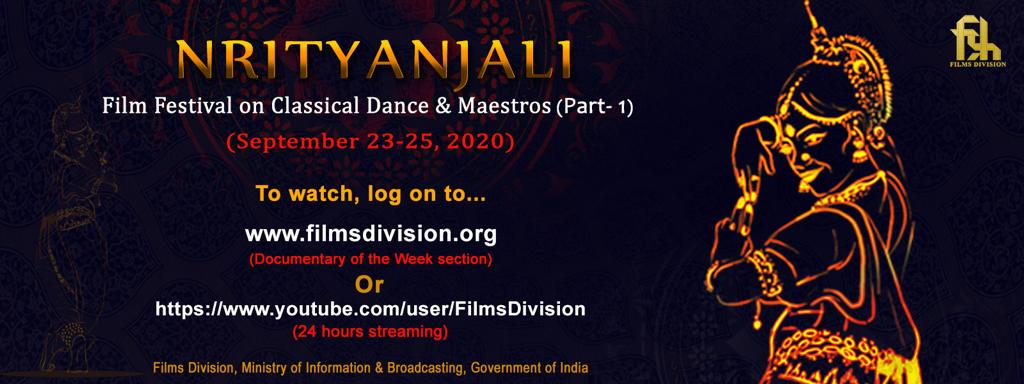Nrityanjali – an online film festival on Indian Classical Dance and Maestros by Films Division
New Delhi:Films Division, Ministry of Information & Broadcasting has come up with yet another fiesta, ‘Nrityanjali’, an online film festival on Indian Classical Dance and Maestros from 23rd to 25th September, 2020. The first part of ‘Nrityanjali’ will showcase 10 films on the life and works of India’s leading classical dancers. The festival will be streamed on Films Division website www.filmsdivision.org/Documentary of the Week/ and its YouTube channel https://www.youtube.com/user/FilmsDivision. All films will be streamed live, simultaneously, for three days.
Details of films/documentaries to be screened:
“Sitara Devi” (20 min./1995/Amar Varma), a film on doyen of Kathak Dance, hailed as the Queen of Kathak by Rabindranath Tagore, honoured with many awards including Padma Shri, Sangeet Natak Akademi Award and Kalidas Samman.
“Yamini Krishnamurthy” (20 min./1981/Balwant Gargi), is on the leading Bharat Natyam exponent who also excels in Odissi and Kuchipudi. She has been honoured with Padma Vibhushan, Sangeet Natak Akademi Award and Natya Shastra Award.
“Raja-Radha” (22 min./1989/Kunwar Sinha), a biographical film on the well known Kuchipudi dancer-couple Raja and Radha Reddy, who gave new dimension to the traditional Kuchipudi dance and honoured with Padma Bhushan, Sangeet Natak Akademi Award and Nritya Choodmani Award.
“Guru Amubi Singh” (17 min./1976/Ashish Mukherjee), a film on the grand patriarch of Manipuri dance, beautifully demonstrates the Guru’s finely honed style of dancing based on the spontaneous rhythm of nature. He received many honours including Padma Shri and Sangeet Natak Akademi Award.
“A Luminous Jewel –Pt. Birju Maharaj” (95 min./1980/V.B.Chandra), comprehensively depicts the life and art of Pandit Birju Maharaj, one of the greatest exponents of Kathak who has been bestowed with many coveted honours including Padma Vibhushan, Sangeet Natak Akademi Award, Kalidas Samman, Lata Mangeshkar Puraskar and National Film Award.
: 2 :
“Kalamandalam Gopi” (43min./1999/Adoor Gopalakrishnan), is on the art and life of eminent Kathakali artist, Kalamandalam Gopi, well known for the romantic and dramatic portrayal of the virtuous ‘pachcha’ roles in Kathakali. He is a recipient of Padma Shri and Sangeet Natak Akademi Award.
“Padma” (35 min./1998/Suresh Menon), a biopic on the acclaimed Bharatanatyam dancer Dr. Padma Subramanyam, talks about her life and art. She is a research scholar, choreographer, composer, Indologist and a teacher of repute and a recipient of many honours like Padma Bhushan, Sangeet Natak Akademi Award, Kalidas Samman and Kalaimamani Award.
“Kanak Rele” (22 min./1997/G L Bhardwaj), a biographical on the classical dance exponent-choreographer, Dr. Kanak Rele, who is internationally known as an exponent of Mohini Attam. She is the founder-director of Nalanda Dance Research Centre, Mumbai and has been conferred with many awards including Padma Bhushan, Sangeet Natak Akademi Award and Kalidas Samman.
“Sonal” (60 min./2004/Prakash Jha), a biopic documents the glorious career of eminent danseuse Sonal Mansingh, as a Bharatanatyam and Odissi dancer-choreographer and as one who is equally adept in other dance forms like Kuchipudi and Chhau. She is a recipient of Padma Vibhushan, Sangeet Natak Akademi Award and Kalidas Samman.
“Dreamer – Swapna Sundari” (29 min./1998/Baba Majgavkar), a biographical film on Swapna Sundari, an exponent of Kuchipudi and Bharatanatyam. She has written books like The World of Kuchipudi Dance and Tracing the roots of the classical dance. She is the founder-director of Kuchipudi Dance Centre, New Delhi. Swapna Sundari has received many honours including Padma Bhushan and Sangeet Natak Akademi Award.
Indian Classical Dance is an umbrella under which various performing arts whose theory and practice can be traced to the Sanskrit text, Natya-Shastra, the foundational treatise by Bharata Muni. Prominent traditional dance forms like Bharat Natyam, Kathak, Kuchipudi, Odissi, Kathakali, Sattriya, Manipuri and Mohini Aattam, include music and recitation in local language or Sanskrit, and they represent a unity of core ideas in a diversity of styles, costumes and expression.

